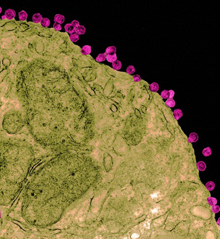Vaccine Clears Away Monkey AIDS Virus
Vaccine Clears Away Monkey AIDS Virus
An experimental vaccine given to monkeys triggered a lasting immune attack that eliminated all traces of an AIDS-causing virus after a year or more. The finding points to a possible new strategy in the search for an effective AIDS vaccine.
HIV, which causes AIDS in people, and the similar monkey virus known as SIV have long been thought to cause permanent infections once established in the body. Even the best antiretroviral therapies can control but not eliminate these infections. Recent studies, though, suggest that both SIV and HIV might be vulnerable to attack and clearance in the first few hours or days after exposure to the virus.

AIDS virus particles (pink) budding from the surface of an immune cell./ Image by R. Dourmashkin, Wellcome Images. All rights reserved by Wellcome Images.
To exploit this vulnerability, a team led by Dr. Louis Picker of the Oregon Health and Science University has been developing and testing a genetically engineered vaccine that includes genes encoding SIV proteins within a modified cytomegalovirus (CMV). CMV is a common, often harmless virus that causes a permanent infection and can thus trigger and sustain a lasting immune response. CMV can cause serious problems, though, in newborns and people with weakened immune systems.
In 2011, Picker and his colleagues showed that when 24 vaccinated monkeys were exposed to an aggressive form of SIV, they all initially became infected. But within several weeks, about half of the monkeys were able to fight the infection and eventually reduce SIV to undetectable levels. In the year after infection, occasional viral “blips” occurred in the bloodstream but waned over time.
In the new study, Picker and his colleagues took a closer look at how the CMV/SIV vaccine elicits immune responses and viral clearance in monkeys. They studied different routes of SIV infection: intravenous, vaginal, and rectal. Their research was funded in part by NIH’s National Institute of Allergy and Infectious Diseases (NIAID) and National Cancer Institute (NCI). The study appeared online in Nature on September 11, 2013.
As in the earlier study, vaccinated animals initially became infected after challenge with an aggressive SIV strain. Viable SIV could be detected in blood and lymph nodes for weeks to months after challenge, regardless of the route of infection. Over time, however, about half of the vaccinated monkeys lost all evidence of SIV. Even ultrasensitive tests couldn’t detect blood- or tissue-associated virus up to 3.5 years after infection.
Additional analysis showed that the vaccine had prompted production of SIV-specific effector memory T cells in protected monkeys. This type of “killer” T cell responds to previously encountered cell-surface molecules—including the fragments of SIV proteins encoded by the genes in the CMV/SIV vaccine—and destroys SIV-infected cells. The researchers found evidence that the SIV-targeting T cells may remain indefinitely on patrol in the body. When the virus emerges, these cells can quickly respond and wipe out infected cells.
“Through this method we were able to teach the monkey’s body to better prepare its defenses to combat the disease,” Picker says. “Our vaccine mobilized a T-cell response that was able to overtake the SIV invaders in 50% of the cases treated. We are hopeful that pairing our modified CMV vector with HIV will lead to a similar result in humans.”
In hope of further improving the vaccine, the researchers are now examining why it works in only about half of the vaccinated monkeys.
By Vicki Contie
###
* The above story is reprinted from materials provided by National Institutes of Health (NIH)
** The National Institutes of Health (NIH) , a part of the U.S. Department of Health and Human Services, is the nation’s medical research agency—making important discoveries that improve health and save lives. The National Institutes of Health is made up of 27 different components called Institutes and Centers. Each has its own specific research agenda. All but three of these components receive their funding directly from Congress, and administrate their own budgets.



















